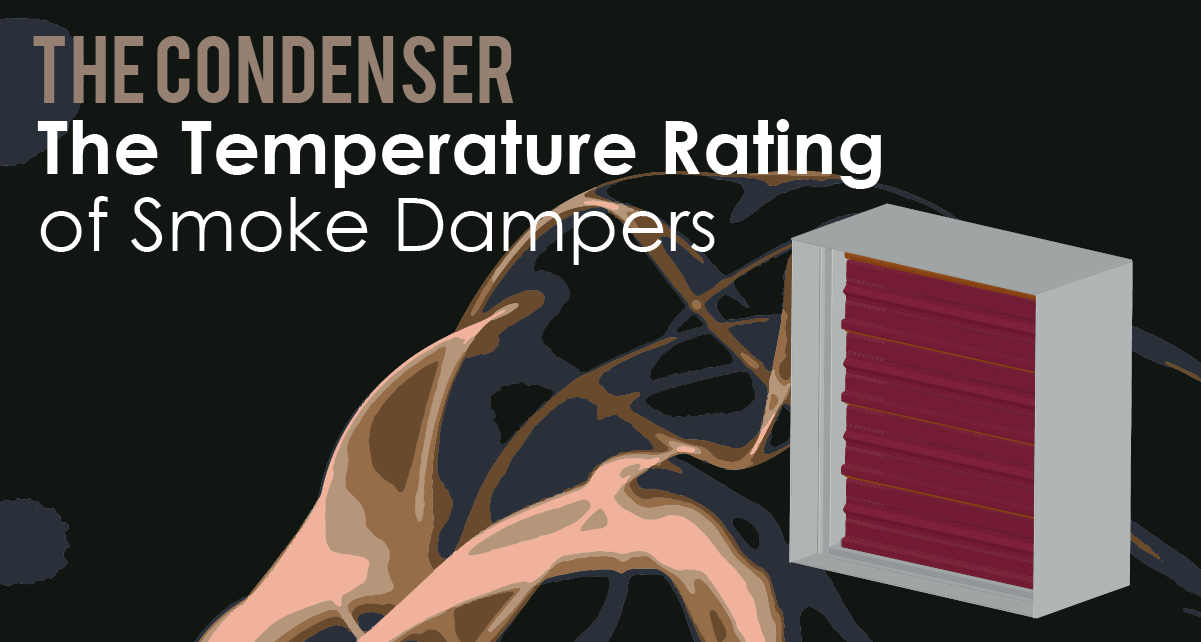Smoke dampers have temperature ratings. Learn what the temperature rating means and the tests involved in determining a smoke damper's rating with this quick Condenser read.
Smoke Dampers and their Temperature Rating
You may have noticed smoke dampers list a temperature rating in their performance data. This temperature rating will be either 250 degrees or 350 degrees Fahrenheit (or 121 degrees and 177 degrees Celsius). What do these numbers mean?

Smoke and combination fire-smoke dampers will receive a temperature rating. This rating refers to the damper's ability to close against super-hot smoke.
This rating does not gauge flame resistance. Fire dampers are tested against intense heat, exceeding 1700 degrees Fahrenheit (927 degrees Celsius), for 90 minutes or more. That is more than five times the highest rating for a smoke damper.
Heat builds as a fire grows and a fire damper needs to stay intact to prevent the spread of flames. Although they aren’t rated for flames, smoke dampers will also need to operate at elevated temperatures.
Temperature Degradation Testing and Operations Testing
The temperature rating of a smoke damper refers to its ability to operate under intense heat. Smoke will be hot. Smoke dampers must close and maintain a seal against the smoke. The damper’s temperature rating is determined through heat degradation testing, conducted in accordance with UL Standard 555S.

In the heat degradation test, a sample damper is baked in a test oven for 30 minutes at a predetermined temperature: either 250 degrees or 350 degrees Fahrenheit, depending on the desired rating.
After baking, the damper is removed and cycled three times while technicians inspect the damper's components. The sample damper should fully close when heated, with all blades coming together. Blade seals should also be fully intact, so that they properly seal the damper against smoke hazards.
In addition, the damper will need to close against a heated airstream at the desired temperature rating, as a part of operations testing, to ensure that it can close against smoke carried through the duct by system fans.
Where fire dampers can be static or dynamic, smoke dampers will always use dynamic closure. They must close the moment smoke is detected in the ductwork, regardless of whether fans are running.

Temperature degradation testing looks at the wear on the damper's components. If the damper can't close or open when it needs to, it won't work as a life safety damper.
All combination fire-smoke dampers will have a fire resistance rating and a temperature rating since they handle both hazards. The damper’s temperature rating will refer to the smoke damper testing. The fire resistance rating refers to how long the damper withstands flames, either 1.5 or 3 hours.
Smoke dampers are designed to contain the spread of smoke through ductwork, which means they need to close against heated airflow. Check the damper’s submittal when selecting smoke dampers for your project.

Designing a smoke control system for HVAC? Consider fire-smoke dampers built by Air Balance. We build every life safety damper to your specifications, so that you meet every requirement. Contact Air Balance today and take a balanced approach to your next project.
Have any experience with designing smoke control systems for HVAC? Tell us about it in the Comments section. We want to hear from you!
For more on dampers, check out these Newsstand articles:
.webp?width=91&height=70&name=MCDLG%20Logo%20(Resize).webp)





